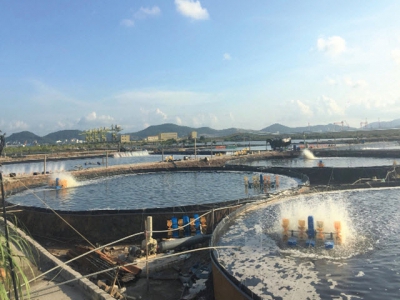Shrimp farming in round cement pond brings high income

A round grow-out pond has a lot of advantages such as saving time, labor, costs, reducing disease outbreaks, preventing direct impact of storms, making shrimps weigh up fast and bringing in high output.
Being one of highly evaluated model by experts in the contest “Farming in the 4.0 era” held in 2020, the project “Shrimp farming in the round cement pond brings in high profit” developed by Nguyễn Văn Vinh (in Từ Thiện village, Phước Dinh commune, Thuận Nam district, Ninh Thuận province) has been applied by more and more local households.
30 years of experience in farming white leg shrimp
In 2015, Vinh decided to rehabilitate the ineffective pond liner to build a round cement pond and became the first person in Vietnam investing into this model.
Talking about his idea of building a round cement pond, Vinh said that farmers had been using a 500 m2 square shaped pond for stocking shrimps, especially as for farming shrimp in growth stage, they used a 1.000-1.200 m2 pond with a shelter above. However, this model has not been steady, does not bring high income, entail a lot of risks, frequently face disease outbreaks and spread among grow-out ponds, that’s why Vinh decided to take risks with building a new model.
So as to build a round cement pond of white leg shrimp, he asked his neighbors to sell him 10ha of land. He built 13 white leg shrimp ponds on 2.6ha land. Those ponds are designed round, built with concrete and rebar and have a useful life of tens of years.
Apply 4.0 technology to operate
This model involves 70% floating and 30% sinking with a modern automatic system inside. The shelter above is made of mesh which can prevent sunlight and birds from eating shrimps or feed.
In particular, each round pond is 2.000 m2 and can contain 4,000 m3 of water. Farmers installs an oxygen bubbler, a separate system of water drainage and shelter which helps control and treat disease outbreaks.
Besides, those ponds are 6m far away from each other, and installed with separate transporting lines of feed, making it convenient when harvesting shrimps. A feeder and bottom oxygen fan system are also installed. Just with mobile phones, they can easily control systems in grow-out ponds and manage the operation.
In Vinh’s opinion, with this round pond model he can be proactive with harvest time, gather discharged substances quickly and conduct more crops per year. The longevity of systems in grow-out ponds can be tens of years.
Besides, this distance among grow-out ponds is clear, creating a good environment for shrimps to weigh up well and increase their vital resistance, bringing an average output of 300 tons per year. Even though shrimp farmers have faced difficulties due to disease outbreaks recently, Vinh hasn’t. With initial success, Vinh invested further 7 billion dong into building 10 grow-out ponds. He now owns 23 shrimp cement ponds, 4.6ha in total.
“With this model, farmers can easily control the amount of feed to stop the leftover from going out to pollute the water environment, eliminating diseases to spread in the water environment and easily controlling pathogens and toxic algae by probiotics. Besides, it is easy to manage grow-out ponds and maintain environmental factors such as degree and PH. In summer, degrees in ponds are assured to prevent shrimps from shocking”, said Vinh.
This round cement pond has been applied by many households with high effectiveness so far. This model has given good results and can be expanded in the future. Besides white leg shrimp, farming models of black tiger shrimp, freshwater shrimp and giant tiger shrimp have been tried by local farmers.
Có thể bạn quan tâm
 Bà Rịa – Vũng Tàu Some achievements from high technology appliance in aquaculture 2017-2020
Bà Rịa – Vũng Tàu Some achievements from high technology appliance in aquaculture 2017-2020 High technology application in aquaculture has shown good results, triggering the continuing development of Bà Rịa – Vũng Tàu’s fishery sector in compliance
 Standard pangasius exported to EU be distributed in Vietnamese northern provinces
Standard pangasius exported to EU be distributed in Vietnamese northern provinces On October 06, the first crates of pangasius produced upon the EU’s standards arrived at Hanoi capital for distribution to northern provinces.
 Ho Chi Minh City use AI for health shrimp and fish monitoring
Ho Chi Minh City use AI for health shrimp and fish monitoring The researchers designed a software to connect with underwater sensing to learn about water, feed and promptly detect possible diseases vulnerable to fish